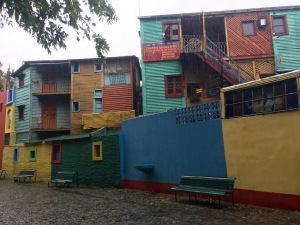
El Caminito, La Boca
Es la catedral (It’s the cathedral), exclaims a portly middle-aged man. He’s reverently pointing to the stadium owned by the Boca Juniors, one of Argentina’s top football clubs. The team is much loved by fans throughout Argentina and adoration tops out here in the Buenos Aires neighbourhood of La Boca. But football is not the only thing that defines this port-side barrio. La Boca is the birthplace of tango; it’s home to the most colourful street in all of Buenos Aires; and its rich history has shaped arts, culture and politics. Even on this cold blustery day, La Boca’s passion is palpable.
Mike and I are addicted to Free Walking Tours and have had great experiences in many cities. Buenos Aires is no exception; we’re on our third walking tour in as many days. We arrive at our meeting point in La Boca and it’s pouring (our only bad weather day in three weeks in Argentina). Luke our guide, an American who has called Buenos Aires home for seven years, is so knowledgable and engaging that we almost forget about the rain.
Prior to 1880, only about one million people lived in Argentina. Between 1880-1930, six million immigrants arrived at the old port of La Boca. Most of them were young men, labourers and tradespeople lured by the promise of free land and housing. The majority came from Italy, which explains why as many as 62% of current Argentinians have some degree of Italian descent.
The promise of free housing didn’t happen and most immigrants ended up in conventillos (tenements). Luke explains how these tenements took on a look of their own as residents gathered scrap material at their work places, mostly at the dock yards—corrugated metal, wood and paint. The assorted paint remnants created a kaleidoscope of colours, since refreshed and on brilliant display around El Caminito (Little Walkway). It’s normally a very touristy place, but today the rain has kept people away.

Colourful and touristy area around El Caminito
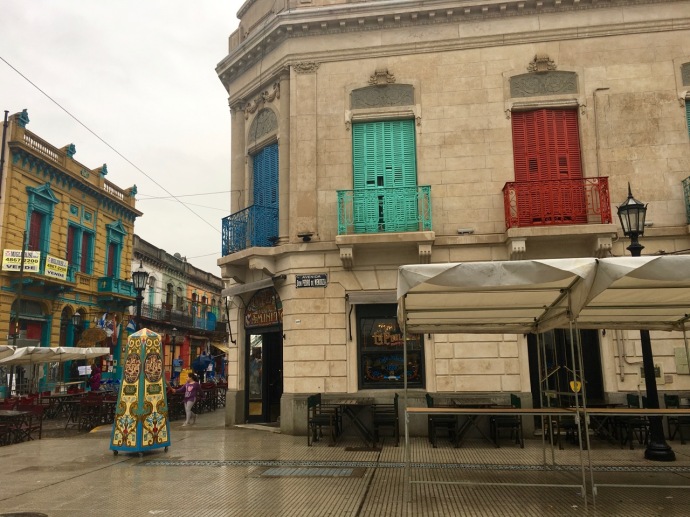
I love the pops of colour on this beautiful building
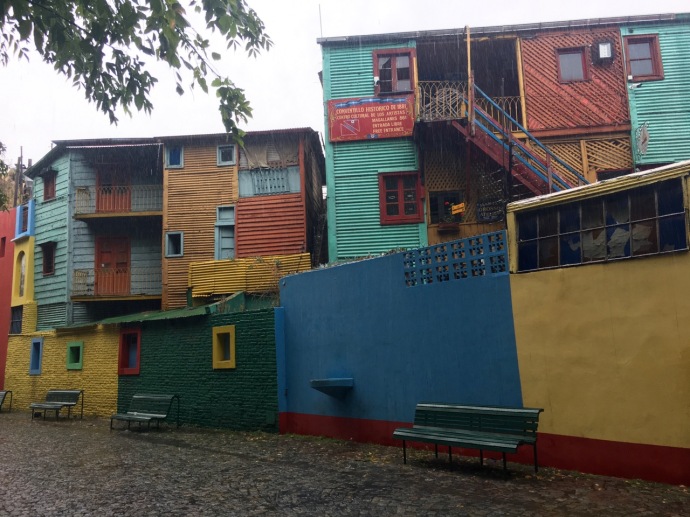
El Caminito brightens up a drab day

There’s great street art everywhere
We explore the little streets around La Caminito and stop to watch a couple dancing a tango on the covered terrace of a restaurant. There’s only a handful of guests and I feel sorry for the dancers. Luke tells us that tango originated from many different musical traditions brought be Italian, Spanish, Russian and German immigrants. Initially, tango was danced by two men due to the shortage of women (80% of then La Boca residents were men). Tango was at first frowned upon by the Buenos Aires upper class. It wasn’t until it was introduced at the Paris Opera House that tango found favour beyond La Boca.
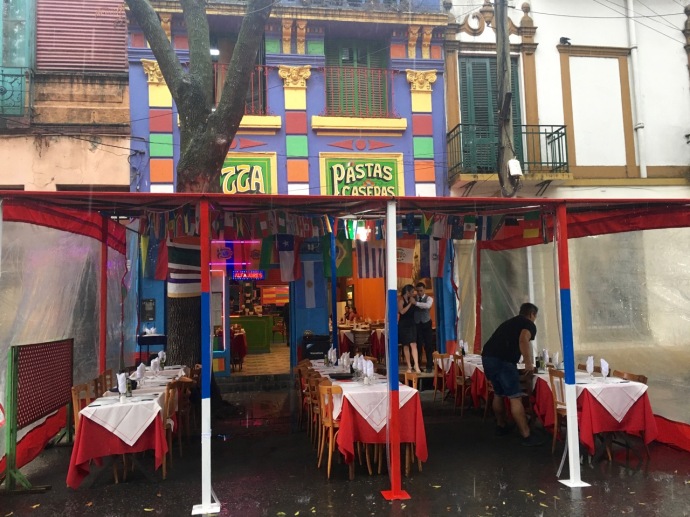
No tourists on this miserably wet day
The rain intensifies as we stand in front of several massive wall murals. Their messages are riveting and I manage to temporarily forget the cold seeping through my body. One of them, emblazoned with the words Republica de la Boca tells the story of late 19th century locals, tired of low wages and poor working conditions, who boldly decide to liberate themselves by forming their own government. It only lasted a few days, but the message still resonates with today’s working class La Boca residents who have a very strong neighbourhood identity.
The most poignant mural for me is the one depicting the Argentinian tragedy of the 70s and 80s were an estimated 30,000 people “disappeared” at the hands of the military dictatorship. Victims included anyone thought to be a political or ideological threat to the government (students, union leaders, journalists…). Out of the tragedy was born Argentina’s most recognized human rights organization: Madres de Plaza de Mayo (Mothers of the Plaza de Mayo). Beginning in 1977, a group of mothers in an effort to learn what happened to their children, started marching in front of the presidential palace at the Plaza de Mayo. To this day, in their iconic white head scarves, they continue to gather there every Thursday afternoon.
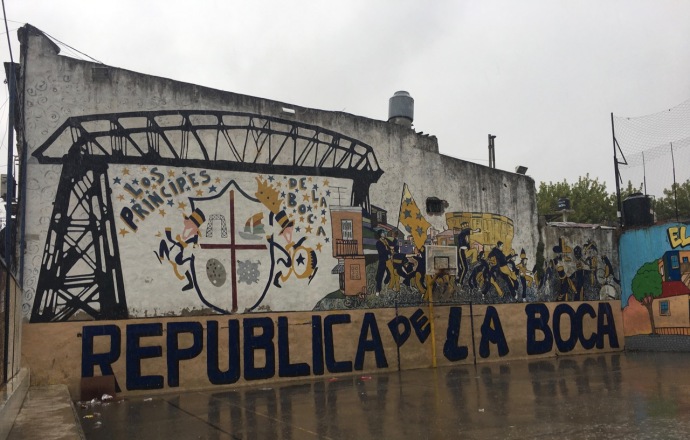
A strong sense of identity and pride in La Boca

Madres de Plaza de Mayo mural

Powerful images on the Madres de Plaza de Mayo mural
The mural is sobering and I’m glad we end the tour on a high note outside La Bombonera (the chocolate box), yet another nickname for La Boca’s famous football stadium. Luke tells us that the stadium actually shakes when there’s a game on. Fans say that it’s “the pulsing heart of God”. How’s that for passion.
I’m shivering as our waterlogged tour disbands. Luke directs us to a local parrilla (grill restaurant). It’s warm and cozy and filled with locals munching on huge pieces of grilled meats.
We’d hoped to do more wandering after lunch but the rain hasn’t let up. Perhaps it’s a blessing because we end up at the fascinating Museo Benito Quinquela Martin. The painter Benito Quinquela Martín (1890–1977), is a local hero who is sometimes referred to as the godfather of La Boca. His paintings of labouring men and billowing smokestacks captures the rawness of early La Boca that had so much influence on Argentina and beyond.
A few tips:
- The touristy area around El Caminito is generally safe, but we were warned by several sources not to venture beyond.
- Leave yourself enough time to get to La Boca. It’s a fair distance from some other part of Buenos Aires and we were surprised how long it took us to get there from Palermo on public transit.
- Free Walks Buenos Aires has daily “free” tours of several parts of the city, where participants pay what they feel the tour is worth/what their budget allows. The La Boca tour is one that actually has a nominal fee attached. Highly recommended.
- A super fascinating way to learn more about the lives of early European immigrants to Buenos Aires is at a tour of El Zanjón de Grandos—a fabulously restored old mansion in neighbouring San Telmo that sits atop a series of underground tunnels that date back to the city’s earliest settlements.
Next up:
I just got back from four weeks of cycling in southwestern Germany and Alsace, French. Lots to come on our “Tour du Vin und Kuchen” (Wine and Cake Tour).





Thank you, Caroline. Wonderful pictures, and experiences, and i think you’ re very talented in writing and in taking pictures. I think you should “play” a bit with some different wp-themes. Do not misunderstand me, i like your blog and because i like it i’m giving you my opinion on this. Take care dear, and thanks again.
LikeLiked by 1 person
Thanks, I appreciate your compliments and comments. From time to time I do think about playing with a different theme but then I get busy and/or nervous that I’m going to mess up my content. One of these days!
LikeLiked by 1 person
Do not rush. You’ re right on this. And this is the reason you have to go (first) to > Settings > export data (you better export your data, here and there)
and then try something like this : create a new site and name it “My test Site” , create a few posts and then play with the templates. There is more you ca do, but this is great for an experimental start.
LikeLike
Pingback: My 10 Perfect Moments in Argentina | Writes of Passage
It is pretty crazy to think of how many people there are today vs 100 or even 50 years ago. One million in Argentina in 1880 is crazy to think about. That is a very colorful neighborhood, and I’ll have to seak out free walks next time I go somewhere new.
LikeLiked by 2 people
Yes, it is astounding how the population grew. Apparently the Argentinian government promoted their need for able young men quite heavily in Europe.
So far we’ve not gone wrong with the free walking tours. They are usually run by young people who are very passionate and knowledgable, and aren’t afraid to offer their opinions on politics, culture etc.
LikeLike
This brought back so many memories of our time there. It was one of our favourite parts of BA. We spent 3 weeks in the city and loved it. I’m intrigued about the story that tango was originally often danced by men. I’d always thought that the tango began in the brothels of BA.
Alison
LikeLiked by 2 people
Hi Alison! Lucky you spending 3 weeks in the city. Our 4.5 days were not enough. Our guide mentioned that it’s a common misconception that tango started in the brothels. The ladies in the brothels were just doing one thing, and it wasn’t dancing. With so few eligible women, apparently the tango got its start among the men in their tenement housing. Interesting stuff!
LikeLiked by 1 person
I love that men would dance together without there being any stigma about it. It seems to be far more acceptable in European countries than elsewhere.
LikeLiked by 1 person
What a fascinating history and vibrant place. I love how the neighborhood has retained character and its values in spite of it becoming a tourist destination. It sounds like a seriously interesting day.
LikeLiked by 2 people
So true! Plus, the touristy area is really a very small section of the La Boca neighbourhood. I would have loved seeing more but apparently it’s not entirely safe.
LikeLiked by 1 person
So sorry your day in La Boca was dampened (no pun intended) by the rainy, dreary day. As you note, though, the place is so colorful, it almost makes up for the drabness of the day! We very much enjoyed the visual feast in La Boca, but parts of the area felt almost manufactured for the tourist, so in a way, you got to see it as it is without the crowds. We are big fans of free walking tours, too!
LikeLiked by 2 people
Hi Lexi! In some ways, the rain did work to our advantage. In addition to the low number of tourists, the harsh weather somehow contributed to the strong emotions I felt as our guide told stories of the hard lives of early immigrants. Being cold and wet seemed more appropriate than basking in glorious sunshine (ha, I say that now in my warm house!).
LikeLiked by 1 person
So great to read about your visit to La Boca as it is a place that has very fond memories for us. In La Boca, we hatched a plan to create an Argentina based business importing ethnic artisanal goods to the U.S. Maybe we just wanted to keep returning to Buenos Aires. And so we did for a few years and made a point always of coming back to La Bocca where it all began for us. To this day tango music, after fifteen years, still floods back all the memories we have of working with Argentian artists and walking in this neighborhood. Thank you for taking us back for a lovely re visit! it has been too long.
Peta
LikeLiked by 2 people
Hi Peta! That must have been a totally fascinating time for you guys, experiencing La Boca as entrepreneurs and really getting to know the local people and this interesting neighbourhood. I’m glad I could take you back. Cheers, Caroline.
LikeLike
Those colors really made a big difference! This is why I believe murals should be encouraged in big cities which otherwise can look rather dull and monotonous. Many places around the world need their own version of Madres de Plaza de Mayo for history is often concealed from the public by those in power. Indonesia is no exception; although the 32-year military dictatorship ended in 1998, the military still has a significant power in Indonesia’s political landscape today, and in imposing a censorship on the reporting of the brutal mass killings that took the lives of millions of purportedly leftist Indonesians back in the 1960s.
LikeLiked by 2 people
You are so right Bama. These murals share important and often tragic stories in a powerful way that is accessible to the masses, and for many, more impactful than reading history books. Hats off to countries who are owning up to their sins, and to dedicated individuals and organizations like Madres de Plaza de Mayo who continue to demand answers and justice. I sadly had no idea that that many people were murdered in Indonesia in the 60s.
LikeLike
What an interesting place to visit. Such great pictures as well Caroline 🙂
LikeLiked by 2 people
Thanks Myra. Glad you enjoyed the post.
LikeLike
Nice blogpost! I’ve been a several times in Buenos Aires and indeed… La Boca is a great colorful touristic hotspot. I discovered it everything on myself: also Almirante Brown and Barracas. This colorful neighboring barrios (Did they show you the mosaic houses? http://www.ostendnomadography.com/the-mosaic-houses-of-barracas/ ) are a stone throw away from La Boca, and listen to the locals:they warn you when you reach the most dangerous parts. La Boca,we can consider it as a “religion”… it’s pure identity. La Boca es La Boca
LikeLiked by 2 people
Thank you! And,thanks for including the link to your post on the mosaic houses. They are amazing! Unfortunately we didn’t get to see them on our tour. We were going to do more exploring but the rain was just too awful. This will be reason to return again.
LikeLiked by 1 person
I am glad you enjoyed Buenos Aires, th most important:). There is so much to see and experience… Hopefully you can get back soon to Argentina:). Regards Stef
LikeLiked by 1 person
This is absolutely fascinating, Caroline. Apart from those colorful houses and its reputation as the birthplace of tango, I knew very little about La Boca before reading your post. Who would have thought the dance started out as an activity between two men? And thanks too for enlightening us about Benito Quinquela Martín and the local stadium. Funny to see how football is practically religion in some countries!
LikeLiked by 2 people
Well James, you knew more than I did before I visited La Boca (I had never even heard of it before researching for our trip). The history of tango is an interesting story, isn’t it! I’m not usually a fan of dark, moody oil paintings but there is something about Quinquela Martín’s work that so captures the rawness of life in early La Boca that it captivated me. Football is religion there, absolutely no doubt!
LikeLiked by 2 people
La Boca would be an interesting place to visit with the strong immigrant/labor history. I remember the ‘missing’, those that disappeared by the thousands -never to be seen again during the political chaos of 70s/80s.. under Pres. Allende or Pinochet, can’t remember. / The new US soccer league is growing in popularity, and Minnesota has a team -the stadium is nearing completion in St. Paul. I wonder how long until national soccer overtakes the NFL in the US? 10-15 yrs. maybe? es muy popular! Great photos! Thanks, Caroline.
LikeLiked by 2 people
Thanks Mike. La Boca is a super interesting part of BA. The “disappeared” tragedy happened in both Argentina (under Gen. Jorge Videla after death of Juan Peron) and in Chile (under Pinochet). I had heard about it before travelling to Argentina, but I didn’t know the horrible extent of it until learning more on this tour. Hmm…national soccer overtaking NFL in the US…I’m no sports expert, but that’s tough to imagine. I do prefer watching soccer to football though!
LikeLiked by 1 person
A lot of people in US enjoy soccer and population is always changing, esp. in recent years, and in lots of large metropolitan areas the Spanish speaking populations are growing very rapidly. My prediction, anyway -within 2 decades soccer will be the top sport! 😉
LikeLiked by 1 person
Haha, hope you’re right and we’re both around to see that happen!
LikeLiked by 2 people